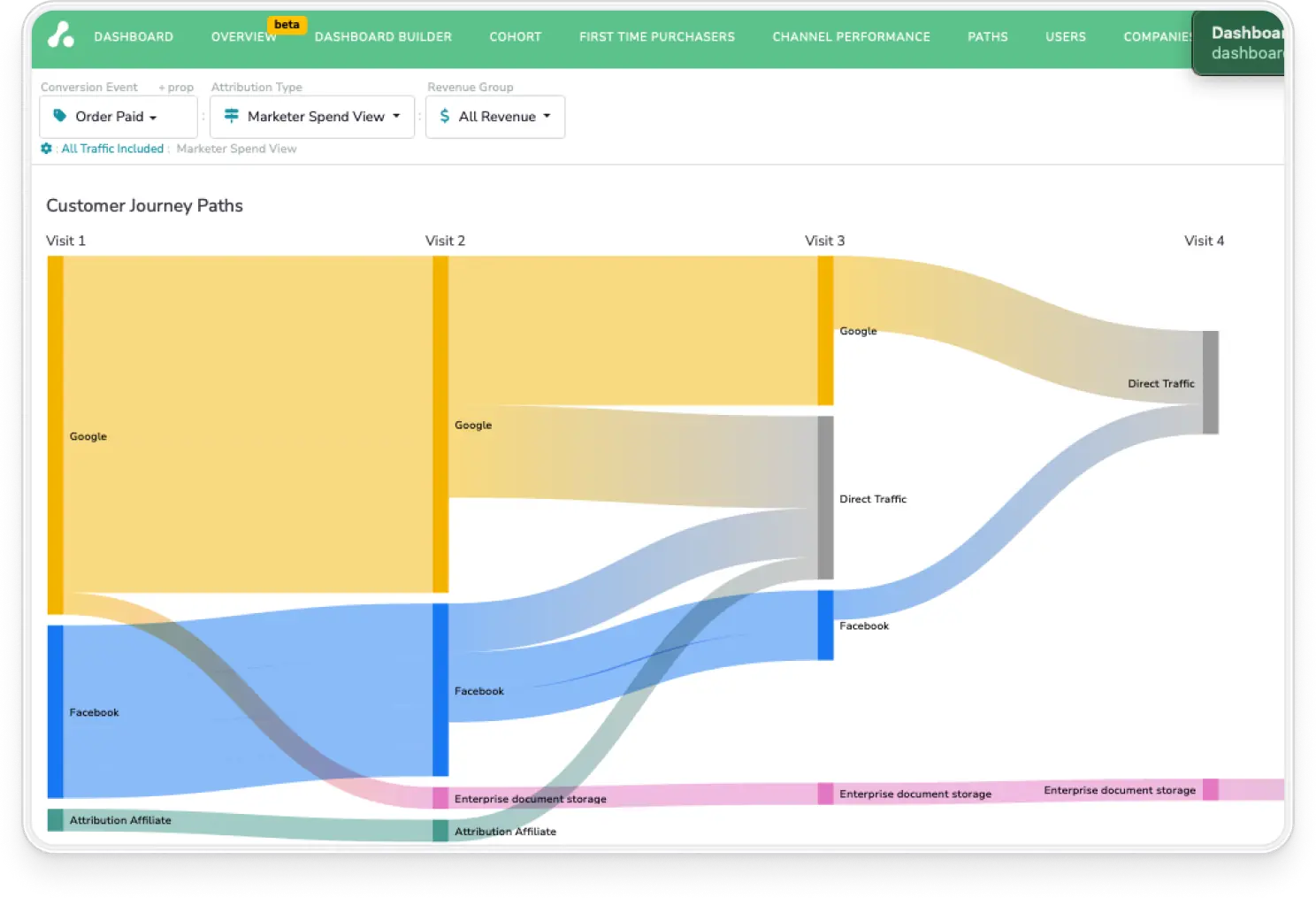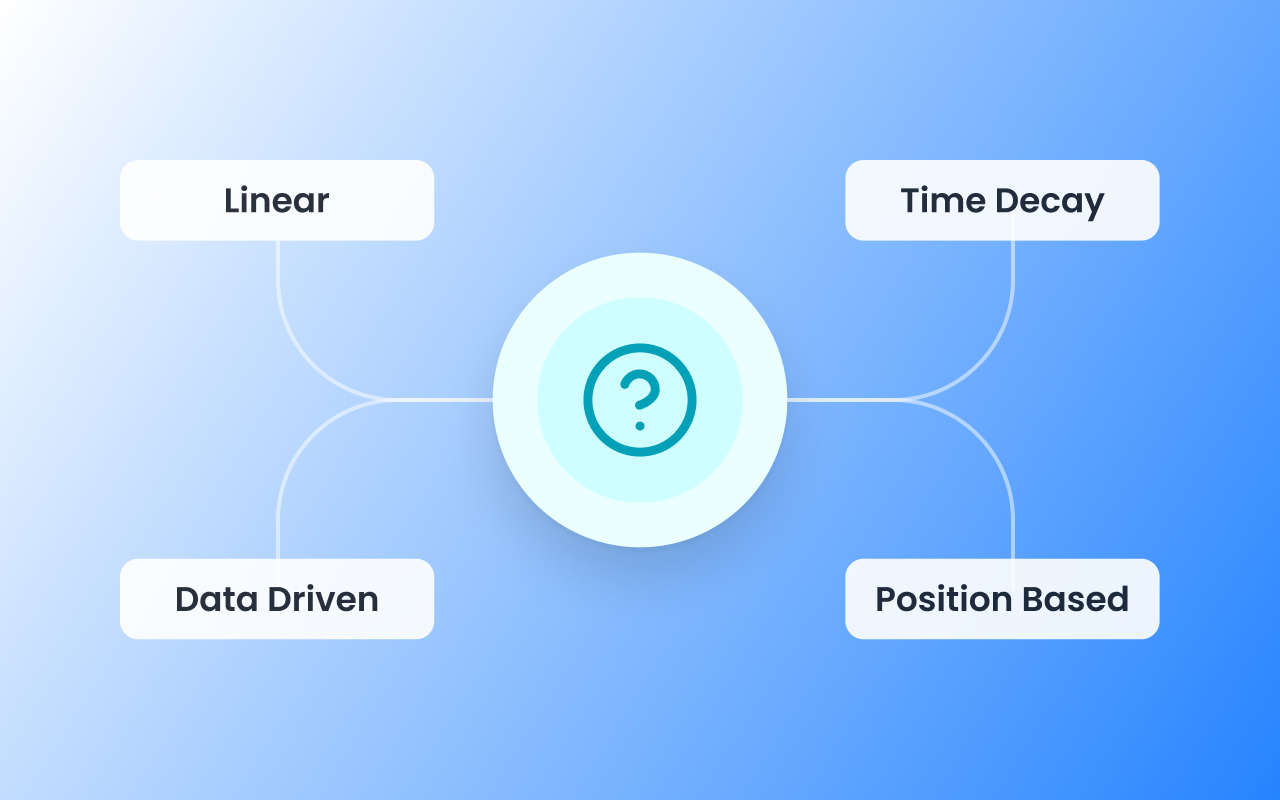In this guide, you’ll gain a better understanding of multi-touch attribution by learning about:
- What it is;
- What problems it solves;
- The different types of multi-touch models (and when they’re right for you);
- Signs that tell you when you should be using it;
- Practical considerations for implementing it; and
- How The Attribution Platform simplifies multi-touch attribution for you.
Key Takeaway:
If your customers typically interact with multiple touchpoints in their customer journey, multi-touch attribution is the tool you need to determine which touchpoints are the most effective and offer the best return on investment.
What Is Multi-Touch Attribution?
Multi-touch attribution (MTA) is the practice of assigning credit to multiple marketing touchpoints in proportion to their impact in driving a desired conversion outcome. The operative term here is “proportion.”
Multi-touch attribution models collect data from all touches in the buyer’s journey and assign proportionate credit based on the attribution weightings of a model, thereby accurately reflecting their impact (or not) in generating a sale or a specified conversion event.
For example, let’s say a prospect or visitor:
- Comes to your website through a search ad;
- Converts to a lead on a newsletter;
- Engages in person with a salesperson; and
- Revisits your website through a remarketing ad to make a purchase for $100.
Multi-touch attribution (using a linear attribution model for illustrative purposes) would assign $25 in proportionate revenue credit to each of the four touches.
Depending on your view of the impact of the recency of the touch, multi-touch attribution models come in different models to easily fit your strategy.
Unlike multi-channel attribution, multi-touch attribution can track any marketing touch with a deep level of granularity. This includes online channels (any source, medium, campaign, etc.), events (any sales touch), email campaigns, and even direct mail, mobile devices, mobile app attribution and television.
Book a Demo
Understand the precise impact of each marketing touchpoint and track “true” CAC, ROAS, and ROI on marketing spend with The Attribution Platform.
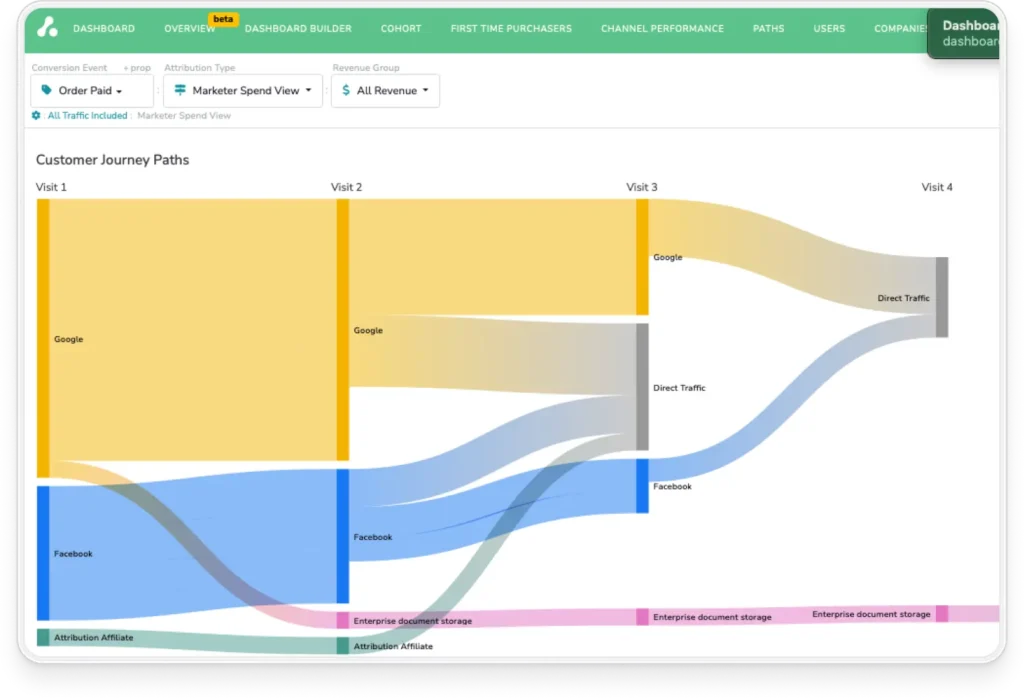
What Problem Does Multi-Touch Attribution Marketing Solve?
Remember the earlier word, “proportionate”? The problem is single-touch attribution allocates a disproportionate amount of revenue credit to either the first or last touchpoint.
If your customers’ purchase path is straightforward, like how ecommerce attribution often is, then single touch attribution is good for informing marketing budget allocation using tools like Google Analytics and your CRM.
However, like most modern B2B and B2C businesses, you’re probably marketing through multiple paid platforms and marketing channels. Offline, single-touch attribution tends to misrepresent ROI by giving 100% revenue credit to either the first touchpoint or last, woefully understating the impact of other touches and channels.
Single-touch attribution data from ad-specific sources such as Google Analytics and Facebook Insights also often double-counts revenue, with each source claiming 100% revenue credit to a sale.
Other approaches like Marketing Mix Modeling have their own flaws. Providers often don’t show you the P-score so you don’t know how accurate the insights are. With this “attribution anarchy,” marketers can’t make data-informed decisions as to which channels and campaigns are worth spending more dollars on and which ones are wasting dollars.
What Are the Different Multi-Touch Attribution Models? Which One Is Right for My Marketing?
Single-touch attribution only gives credit to one marketing touchpoint, while multi-touch attribution models assume all different touchpoints play some role in driving a conversion such as a lead, pipeline or a sale.
Here we’ll look at the most popular multi-touch attribution models and how you can choose the one that will give you the deepest insight into revenue and lead attribution.
Linear Multi-Touch Attribution Model
A linear or “impartial” model is the baseline for multi-touch attribution models. It assigns an equal percentage of revenue credit to each touch regardless of its recency in the buying journey. Using the earlier example, each touchpoint receives an equal $25 in revenue credit, totaling $100.
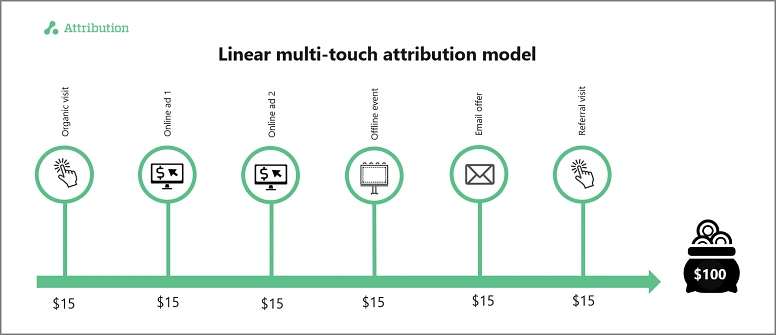
If you don’t have a strong view of the value of when the touch took place in the buying journey, then a linear model is an excellent starting point. The good news is with a modern multi-touch attribution tool you can easily toggle between attribution models to see the differences and start learning.
Time-Decay Multi-Touch Attribution Model
A time-decay model assigns revenue credit to each touch based in accordance to its recency in the buying journey. While a linear model gives equal credit, a time-decay multi-touch attribution model says the closer the touch was to the sale or conversion event, the more influential it was.
You can see the more recent touches receive more credit than the older ones, using the same buyer journey.
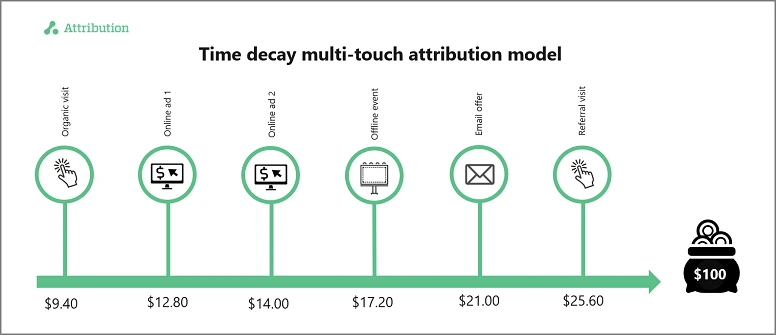
If you believe strongly (and have some supporting data) that more credit should be allocated to touches that nudged prospects closer to a sale vs touches that brought the lead or buyer in, then a time-decay multi-touch attribution model is the way to go.
Position-Based (Or U or W-Shaped) Multi-Touch Attribution Model
A position-based (or U or W-shaped) model assigns 40% revenue credit to the first and last touch prior to the conversion event or sale. The remaining 20% is distributed equally among the middle touches.
A position-based multi-touch attribution model would give 100% revenue credit to the touch if there is only one touch before a conversion event or sale. Similarly, if there is only a first and last touch, they each receive 50%.
Let’s look at our example to see how these models work:
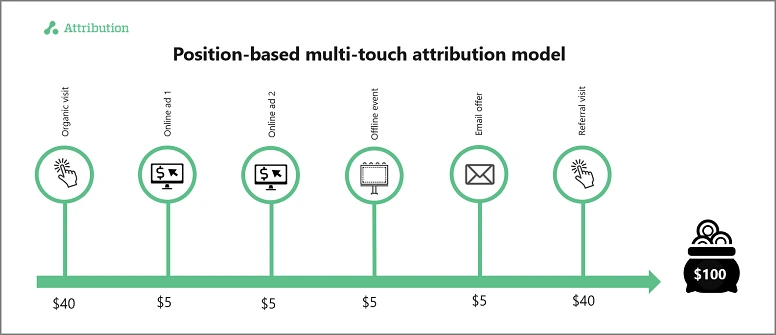
Note: A W-shaped model works the same as a U-shaped attribution model except it allocates 30% revenue credit each to the first, key middle, and last touch, while distributing equally the remaining 10% among other middle touches.
If your business places more value on the touch that brought in the initial prospect and the touch that converted them compared to the middle of the buyer journey touches, then you should use a position-based multi-touch attribution model to optimize your campaigns and channels.
Data-Driven Machine Learning Multi-Touch Attribution Model
The most advanced approach to multi-touch attribution is custom machine learning modeling. A custom attribution model uses a machine learning algorithm to assign revenue credits to touches.
An algorithm is derived using historical touch and conversion data, rather than using a static model with user-determined weightings as in the above examples. Data-driven attribution modeling applies a unique algorithm to allocate credits, as you can see in the example below.
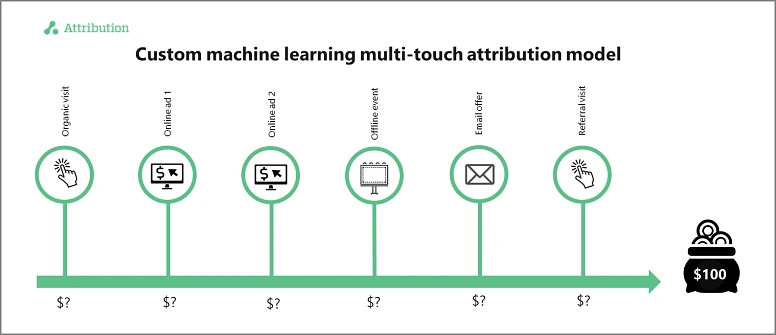
For this reason, you should not expend the effort with it until after you’ve gone through at least one or two full path buying cycles using one or more of the static models.
If your business is direct-to-consumer with a short purchase path, this means a matter of a few weeks. But if you’re dealing with longer B2B buyer journeys, it’s best to learn from the static models for six or more months depending on your sales cycle to determine if there is opportunity to optimize your marketing mix.
There’s no perfect science for choosing the right multi-touch attribution model. As the use of multi-touch attribution to optimize budgets and channels matures, marketers will run several models at one time to see which one is right for their business. The good news is modern multi-touch attribution tools allow you to see and compare the results from each model.
5 Signs That Your Company Is Ready for Multi-Touch Attribution
Multi-touch attribution is worth the effort if you’re on the hook for lead or pipeline generation and/or customer acquisition or purchase, regardless of whether you’re a B2B or B2C marketer, and you’re:
1. Using Multiple Digital Ad Networks
Many companies are using various digital ad networks such as Google Ads, LinkedIn Ads, AdRoll, Facebook Ads, and others. As the number of ad channels grow, single-touch attribution crumbles under the tracking complexity.
With less linear and more complicated customer purchase paths, multi-touch attribution effectively manages the attribution intricacies of different ad channels (and the products and metrics within each channel required) for informing budget and revenue allocation across the different ad platforms.
2. Using or Considering Using Offline Channels
Common offline channels include direct mail, conferences, stores and/or sales touches. The moment you expand beyond digital marketing and do offline marketing is the moment single-touch marketing attribution tools stop giving you holistic and accurate visibility of the ROI of your online and offline channels.
Multi-touch attribution is channel-neutral, thereby allowing you to accurately compare ‘apples to apples’ ROI between online advertising and event spending, as well as the insight within each offline channel.
3. Using or Considering Using SEO to Spur Brand Awareness and Qualified Traffic to Your Site
Only multi-touch attribution can connect anonymous touches from your blogs and web pages and accurately attribute revenue and cost using the same model (and conversion data) as your other channels.
4. Spending More Than $250,000 Annually to Drive B2C Sales or $500,000 Annually to Generate Qualified B2B Leads or Pipeline
This is considered a general inflection point where your marketing efforts are increasingly better spent on knowing which channels and campaigns are working and which ones need to be purged for poor ROI vs getting mired in attribution chaos due to lack of true attribution insight.
5. Trying to Optimize Budgets Using Single-Touch Attribution From One or More Tools
If you have a short and simple marketing funnel, a single-touch model (e.g., first-touch attribution or last-touch attribution) may be good enough. But if you’re marketing on various channels, have many touch points and are nearing “attribution anarchy” with single-touch tracking, you’re ready to move to multi-touch attribution marketing to augment your decision-making. Now.
What You Need to Know About Implementing Multi-Touch Attribution
Once you’ve decided that multi-touch attribution is the right move for your business, you should start thinking about the practical factors of implementing it. These factors go beyond choosing the right model. Here’s what you should think about:
- Determine your lookback window: A lookback window is the timeframe you use for tracking touchpoints before a conversion. Shorter windows (i.e., <7 days) capture more immediate interactions, which is ideal for quick-purchase products. Longer windows (i.e., >14 days) better reflect extended buying cycles, like high-consideration purchases or B2B ABM strategies. Regularly review your lookback windows based on your actual customers’ buying behavior.
- Unify your data sources: Effective multi-touch attribution relies on integrated data from your various marketing channels. Centralizing your data into one platform creates consistency and accuracy, providing a complete view of customer interactions. Tools like The Attribution Platform or Customer Data Platforms (CDPs) can simplify this process.
- Standardize naming conventions: Consistent naming conventions across campaigns, channels, and touchpoints are essential. Clearly defined and standardized labels make your reporting more accurate and easier to analyze—helping you or your team quickly interpret results and act on insights. For example, label your email campaigns with the format “CampaignName_Channel_Date” (e.g., SpringSale_Email_Mar2024).
- Invest in data hygiene: Data hygiene significantly impacts the effectiveness and accuracy of attribution insights. Regularly validate, deduplicate, and update customer data. Implement processes to maintain data integrity, making sure your analyses reflect true customer journeys.
By keeping these practical considerations in mind, you’ll set yourself (or your team) up for successful multi-touch attribution and you’ll start turning complex insights into clear, actionable marketing strategies.
Multi-Touch Attribution Marketing with The Attribution Platform
Since buyer journeys span many touchpoints and devices before converting, you need to understand which touchpoints a buyer (or buyers) interacted with that resulted in a positive action.
The goal is to understand where to focus marketing spend. This involves devoting funds to higher performing channels and campaigns and diverting dollars from those that were ineffective.
But without the right tools, accurate and transparent multi-touch attribution is almost impossible. That’s where The Attribution Platform comes in.
With the click of a mouse, you can look at all channels and attribute sales to those touches using various models. You can also look at user-level data that touches on key conversion goals such as leads, signups and purchases.
The Attribution Platform is a multi-touch attribution solution that helps you to better understand both the chronology and the type of interactions that preceded and influenced conversions. It then accurately apportions conversion credit to touchpoints, which offers insights through metrics like:
- Return On Investment (ROI)
- Return On Ad Spend (ROAS)
- Customer Lifetime Value (LTV)
- Customer Acquisition Cost (CAC)
- CAC Payback
- LTV:CAC ratio
Accessing these metrics specific to each channel/touchpoint gives you the clarity you need to allocate your marketing spend more effectively.
Sign up and try Attribution today — pinpoint CAC by channel, audit funnels and conversion rates, scale revenue-driven content marketing, measure affiliate LTV and CAC (and more).
